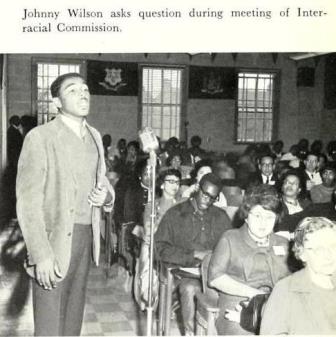
Wednesday, May 30, 2018
A Mississippi Civil Rights Museum exhibit highlighting the role protest marches played in the movement includes a 1966 photograph of a 22-year-old black man wearing a Maryland State College t-shirt.
The museum in Jackson, the state capital, acquired the image from Alabama’s Department of Archives and History, home to a repository of revealing civil rights-era photos.
For more than half a century, the identity of the serious young man who appears to be clapping and shouting encouragement to fellow protesters was a mystery.
No longer.
The confluence of America’s post-World War II struggle to address its history of segregation, the evolution of the Internet and the ubiquity of cellphone cameras finally gave the activist a name.
This is the story of that journey.
* * *
It started on a Sunday – Dec. 10, 2017 – with a chain of e-mails.
Mississippi native Randall Pinkston, a former CBS News correspondent, and Steve Crump were among the first visitors to the civil rights museum during its opening weekend.
As Pinkston and Crump made their way through the exhibits, they spied a poster-sized image suspended above them featuring a young man clad in a Maryland State t-shirt and immediately thought of their friend, H. William Jones III. The man everyone knows as “Bill” is an unabashedly proud University of Maryland Eastern Shore alumnus blessed with encyclopedic recall of his alma mater’s history.
Crump, a reporter with WBTV in Charlotte, snapped a slightly distorted picture of the poster using his cellphone and sent it to Jones at his home in Cornelius, N.C., along with some good-natured ribbing.

Jones grew up on the UMES campus and thought he recognized the face. He forwarded Crump’s photo to the UMES public relations office with a confident assertion that the man’s roots could be traced to Princess Anne.
The ready-and-able network of UMES alumni, friends of the university and its neighbors was mobilized the next day to assist in solving the mystery.
Retired UMES professor Ernest Satchell immediately thought the face familiar, too, and knew where to turn. In a matter of hours, Satchell (a 1963 Maryland State alumnus who grew up on the Eastern Shore of Virginia) had an answer.
After consulting with William Dennis, a high school contemporary of the mystery man in the picture as well as the man’s family still living in Princess Anne, Satchell said everyone agreed the protester in the museum photo is Johnny Wilson. Other alumni from that era who have since seen the image concur.
Wilson, who died in 1993, was raised in Princess Anne by his grandparents Walter J. and Laura Parsons Maddox, graduated from old Somerset Junior / Senior High School and was a leading campus activist when he was a Maryland State student between the spring of 1963 and the fall of 1965.
The civil rights movement across the Deep South beckoned, however, and Wilson left college to join the likes of Dr. Martin Luther King Jr., Andrew Young and Ralph Abernathy as well as more strident activists, Stokely Carmichael and Dick Gregory.
Like caterpillars who become butterflies, Wilson’s social activism evolved into public service. In 1974, John Augustus Wilson was elected to the Washington, D.C. City Council when the nation’s capital achieved home rule. Today, the municipal government office building bears his name.
* * *
In June 1966, civil rights icon James Meredith embarked on a 220-mile trek from Memphis, Tenn. to Jackson, Miss. to draw attention to voter registration. Four years earlier, he became the first black student to enroll at the University of Mississippi under federal court order.
Shortly after leaving Memphis on June 5, a sniper shot Meredith but he was not grievously injured. Nevertheless, thousands of fellow civil rights activists stepped in to continue Meredith’s voter-registration awareness campaign that attracted wide-spread media attention. By the time he rejoined the effort as activists neared Jackson, it was being called the “March Against Fear.”
Among those chronicling the Meredith march was Jim Peppler, a young photojournalist working for the Southern Courier, a weekly newspaper based in Montgomery, Ala.
Later in life, Peppler donated his civil rights-era photo portfolio to the Alabama state archives, which converted them into digital images and posted them online. The mostly black-and-white pictures capture a movement reflecting the struggle, the tension and the energy of an important chapter in America’s history.
Understandably, Peppler had little time to record the names of the thousands he photographed. In the Alabama archives featuring Peppler’s collection, Wilson was described as a “man in a Maryland State College t-shirt.”(1)
Peppler’s lens captured weary protesters, agitators with Confederate flags, and police acting as buffers and enforcers. There are also images of entertainers Marlon Brando, Tony Franciosa and Burt Lancaster who showed up to support the movement.
The image of Wilson in the Mississippi Civil Rights Museum is not the only one of him in Alabama’s state archives.
Another is of a visibly weary Wilson, wearing what appears to be the same t-shirt and holding a half-full soda bottle with an iconic profile that a well-known soft drink manufacturer still uses today.
Affixed to the left side of Wilson’s shirt in that second picture is a small button. It reads: “I BELIEVE IN HUMAN DIGNITY.”
(1) – After UMES shared its findings, the Alabama Department of Archives and History updated captions on the two pictures of the protester in the Maryland State College t-shirt and both now identify him as John A. Wilson.

